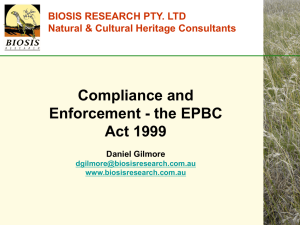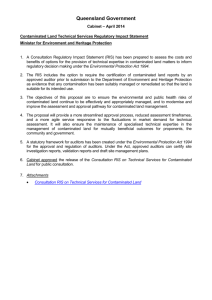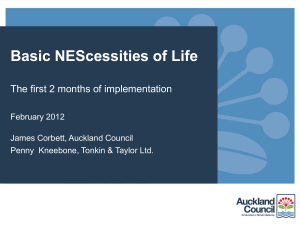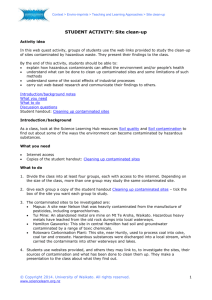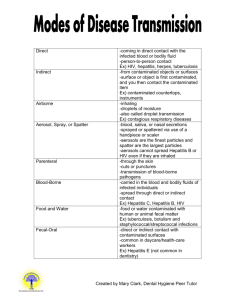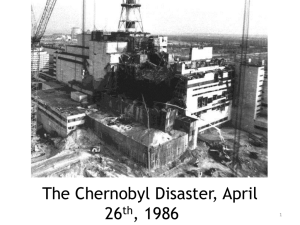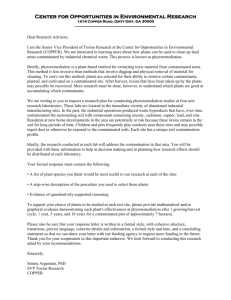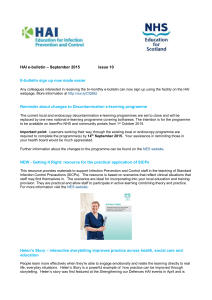NES Workshop Final Minutes 2013
advertisement
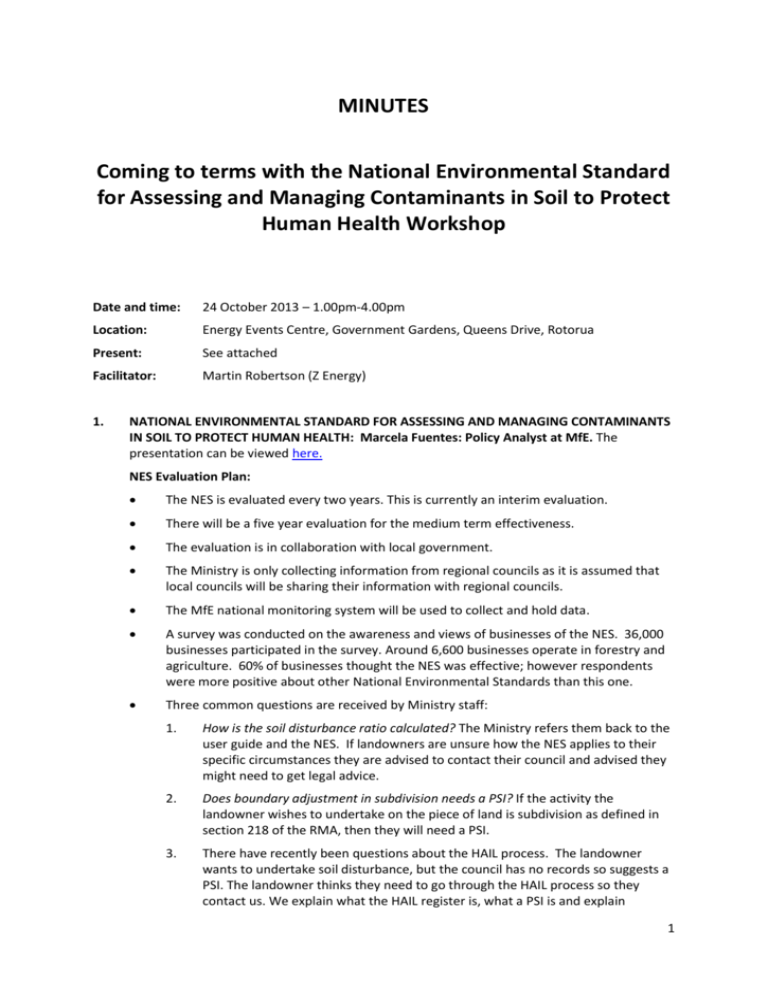
MINUTES Coming to terms with the National Environmental Standard for Assessing and Managing Contaminants in Soil to Protect Human Health Workshop Date and time: 24 October 2013 – 1.00pm-4.00pm Location: Energy Events Centre, Government Gardens, Queens Drive, Rotorua Present: See attached Facilitator: Martin Robertson (Z Energy) 1. NATIONAL ENVIRONMENTAL STANDARD FOR ASSESSING AND MANAGING CONTAMINANTS IN SOIL TO PROTECT HUMAN HEALTH: Marcela Fuentes: Policy Analyst at MfE. The presentation can be viewed here. NES Evaluation Plan: The NES is evaluated every two years. This is currently an interim evaluation. There will be a five year evaluation for the medium term effectiveness. The evaluation is in collaboration with local government. The Ministry is only collecting information from regional councils as it is assumed that local councils will be sharing their information with regional councils. The MfE national monitoring system will be used to collect and hold data. A survey was conducted on the awareness and views of businesses of the NES. 36,000 businesses participated in the survey. Around 6,600 businesses operate in forestry and agriculture. 60% of businesses thought the NES was effective; however respondents were more positive about other National Environmental Standards than this one. Three common questions are received by Ministry staff: 1. How is the soil disturbance ratio calculated? The Ministry refers them back to the user guide and the NES. If landowners are unsure how the NES applies to their specific circumstances they are advised to contact their council and advised they might need to get legal advice. 2. Does boundary adjustment in subdivision needs a PSI? If the activity the landowner wishes to undertake on the piece of land is subdivision as defined in section 218 of the RMA, then they will need a PSI. 3. There have recently been questions about the HAIL process. The landowner wants to undertake soil disturbance, but the council has no records so suggests a PSI. The landowner thinks they need to go through the HAIL process so they contact us. We explain what the HAIL register is, what a PSI is and explain 1 Regulation 6. Landowners can choose to reply on information from council or undertake a PSI. Q and A: 2. What’s the timing on the interim evaluation? We are planning to undertake it in 2014, but at the moment I think we have enough information on what the key issues are. Is there a move to make PSI’s mandatory? No there are not any moves to make it mandatory. It is compulsory now, if the activity to be undertaken is subdivision. The NES was going to be the first building block for dealing with contaminated land, when will further work be done in this area? Nothing is planned at this stage. We are interested in having more opportunities to give feedback as part of the WasteMINZ contaminated land sector group. We would like to be part of the current process of examining the data that has been collected and identifying the key issues. We are compiling a list of key issues which we think need addressing. James Court: a technical advisory group of no more than 20 people who could work with MfE on specialist issues is needed e.g. asbestos in landfill STAKEHOLDERS PERSPECTIVES ON THE NES Waikato Regional Council (Michelle Begbie): the presentation can be viewed here. o Our interest in contaminated land comprises human health and environmental health. o The good things we have witnessed are: A much stronger interest in the quality of the HAIL register. It has driven software improvements and there has been a huge increase in the number of questions fielded about contaminated land. o However issues which have arisen include: Some of the guidelines are outdated; regional authorities have no direct NES function (and there is sometimes confusion about this), environmental health is now often overshadowed by human health considerations. o We need to digitise the historic crown archive of images to speed up the process of finding photos. o We need real time information sharing with TAs. Rotorua District Council (Jo Watts): the presentation can be viewed here. o Rotorua has contamination from timber processing, but has less dairying and horticultural contamination than other regions. There is also natural arsenic from geothermal processes. o Rotorua is covered by two regional councils so we have two HAIL lists to work off. o There is confusion for customers over different guideline values applying, and environmental health v human health. The environmental health side is not covered under the NES. o We have a permissive industrial zone so it is a challenge to channel activity through to the regional council. o There is the issue of “pieces of land”. 2 o Auckland Council (James Corbett): the presentation can be viewed here. o There is no single combined or integrated database across council. o There is a move to replace staff with a science background to staff with a planning background. o There is no overarching council policy for the management of contaminated land. We estimate there are over 10,000 council owned HAIL sites. o The council information held is not the same quality as that of a PSI. o There are issues of nitrate pollution in Pukekohe and wide scale asbestos issues. There is also an issue of soil movement as most houses are built on concrete slabs. o We need more real life examples of how to deal with problems. How do we deal with sites which border contaminated sites? Golder Associates (NZ) Ltd (Simon Hunt): the presentation can be viewed here. o Rotorua Council records lack information on historical activities on rural land such as sheep dips. Reports should be peer-reviewed. Burton Planning Consultants Ltd (Karen Blair): Tank removal and replacement. The presentation can be viewed here. o Piece of land and site boundaries don’t always match. o There is no maximum cap on soil disturbance: it is proportional to the size of the ‘piece of land’. o A DSI is not appropriate to a service station site due to the risks involved in undertaking the investigation. Also the primary risks and factors are already known, as they are related to the nature of the activity and are similar for all sites. The best time to assess is once the tank has been removed. At that time, validation can occur. o A historical report may be acceptable as a DSI. For the purposes of the NES the question is: does the report supply sufficient appropriate information? o There should be a good reason to question the material which is provided and certified by a SQEP. o The NES should not be an excuse to impose a whole range of monitoring requirements beyond what is required for the intended use of the site. Even if an activity is discretionary under the NES then extra conditions shouldn’t be applied by council. Councils should consider suggested conditions on applications. o When a DSI is done it can be fit for a number of different purposes. Assessment pursuant to the NES should stick to the human health aspects: concerns relating to sea level rises are not relevant to NES consent conditions. Q and A 3 3. James Court, BP Oil: We were working towards a comprehensive framework for contaminated land. In creating a road map we consulted around the country. In 2007 there was a position paper with a road map for life beyond the NES. “Working towards a Comprehensive Policy Framework for Managing Contaminated Land in New Zealand” Ministry for the Environment position paper, 2007. There is a list of the elements needed for a comprehensive framework. It is a good starting place for where to next. Marcus Herrmann, Auckland Council: Auckland Council provided input back in 2005. The prioritised list is still relevant, so there is no need to reinvent the wheel. There has been a gap in coordination with MfE. A local government task force met three times to provide input. We don’t need two years of new consultation. What we do need is targeted workshops on specific issues. Tricia Scott, NZ Environmental: How many people are recording higher than 0.8 cadmium on rural sites? Kelly Diehl, Waikato District Council: Cadmium in soil is an issue with us as well. It is hard to know when to ask for an investigation as a lot of building is being done on formerly rural land. After a site has been assessed with PSI and DSI and the site is found to be clear does the HAIL designation come off the register? Michelle Begbie, Waikato Regional Council: No the HAIL registers should remain a repository of both current and historical information. We need to make sure the right information goes to the right places. Auckland Council has just scanned 60,000 pages of information Martin Robertson, Z Energy: There is an issue of consistency of land use registers. Michelle Begbie, Waikato Regional Council: A national database concept is possibly reaching too high. Registers are continually improving. Guideline Number 4 is quite a high priority for us. There is a lot of work going in to making the land register information available. The next step is making them available to the public. Six regional councils will be adopting IRIS, the exact same software. Contact Michelle Begbie at Waikato Regional Council for more information. Simon Hunt, Golder Associates: We have done a health risk assessment on one site. If the vapour concentrations increase, more remitigation will be needed. If that happens how will that information be captured? I have no confidence that that information would be recorded. Hamish Wilson, Pattle Delamore Partners: The NES could create a logjam at council level in terms of resources. Has additional funding been sought by various councils to cope with the logjam? Rotorua Council: we don’t have a jam at this stage, but it is always hard to get additional staff resources with this economic climate for extra regulatory processes. IMPLEMENTATION OF THE NES: LGNZ (Clare Wooding): The presentation can be viewed here. Clare undertook a survey of councils and received 30 responses. Q and A 4 4. Auckland Council - needs resources to up skill staff as they come from other backgrounds and are dealing with complex issues. Consultants need to recognize that there is a new range of people dealing with these issues. Resources from last year’s workshop on the WasteMINZ website are useful for those who are new to dealing with contaminated site assessment. View these resources here. James Corbett – I’m concerned that the framework has sat static. The WasteMINZ sector group could feedback on reprioritization of issues. The issues can’t be tackled one by one as often they need to be tackled together. The number of TAs in the audience is 17. We have all given feedback to the RMA biannual survey back in July, which was compulsory. WAIKATO CONTAMINATED LAND LIAISON GROUP (Michelle Begbie, Waikato Regional Council and Kelly Deihl, Waikato District Council): The presentation can be viewed here. The regional council approached the CEOs first of the district and city councils and got their buy in to approach staff. There is a diverse membership, not just council staff. Q and A 5. How can other councils pick up on that? We are happy to share our experiences. We have already done this with Bay of Plenty and they now have their own group up and running. We are happy to share our terms of reference with anyone who is interested. Environment Canterbury have a group and Wellington has kicked one off, so we are not unique but we are vocal. We mapped the structure of the group to the Regional Waste and Contaminated Land Forum structure. SQEP ACCREDITATION UPDATE (Simon Hunt, Golder Associate (NZ) Ltd): The presentation can be viewed here. We are hoping to hold a national contaminated land conference next year in partnership with WasteMINZ and Australasian Land and Groundwater Association. Q and A Marcella Fuentes: How many people would have 10 years or more experience in NZ? In yesterday’s session 12 people put their hand up when this question was asked. Simon Hunt: six out of 14 at Golder Associates could become accredited, if that’s what they wanted to do. Graeme Proffitt: We have about half a dozen who could get through that threshold. However, we would still choose to have only two or three people signing off the reports, as an internal process. Peter Murphy: IPENZ is breaking down chartered engineers into specialist categories. That might be something to look at e.g. specialist in old orchard work but not hydrocarbons. Martin Robertson: If someone meets the referee requirements, then even if they haven’t done one type of work before, they probably still have the skills 5 John O’Grady: there is no continuing professional development for HSNO. There are 22 different categories of test certifiers for HSNO. EPA was the certifying body for HSNO Test Certifiers and could also be (or MfE) for SQEPs. 6. 7. Simon Hunt: I have asked Golder Associates internationally what happens in other countries and no other country has a scheme with multiple categories for accreditation. Graeme Proffitt: It is a code of ethics issues. If you are not competent to do it, you shouldn’t put your hand up for it. A suggestion was made to put up links to ITRC training on the WasteMINZ website. Prescriptive guidelines for change of land use could allow for a lower level of sign off, as most SQEPs and consultants are based in larger centres. GUIDELINE NO. 5. This was referred to throughout the workshop, so all discussion relating to Guideline No. 5 is listed below. Waikato Regional Council: We would appreciate an update of the guidelines starting with Guideline No.5. Golder Associates: Guideline Number 5 needs revising. Graeme Proffitt: Rural residential properties - are they production land or not? Partial investigations occur, which only include part of the site. There should be application guidance with the NES on how to apply the numbers. This should be in Guideline No.5. What do these numbers mean? How do we apply them? Marcella Fuentes: I hear that Guideline No. 5 needs to be updated? But in terms of what? I have heard from some people that they want a simpler guideline which is less complicated, but from others that they want more detail and more examples. Graeme Proffitt: We were involved a few years ago in updating the guideline. We wrote a draft and then we added statistical information, but we got the feedback that they wanted a brief recipe book. However, the topic is too complex for simple outcomes. The audience is not only councils but regulators, land owners and consultants. Martin Robertson: Contaminated Guideline No. 5 was not written in the context of the NES. Ross McFarland: I can’t understand the beat up over Guideline No. 5. Some references may need updating but the rest of it looked very useful. The Australian NEPM (National Environment Protection Measure) is in nine schedules and is almost identical to guideline number 5. Guideline No. 4 is a high priority for us. WHAT HAVE THEY DONE IN AUSTRALIA AND WHAT COULD WE LEARN? Ross McFarland, AECOM: NZ practice is as good as the rest of the world in this area. You can build off what is already happening. There are very useful resources on the MfE website: guidelines for timber preservation, gasworks etc. You could update guidance by taking out the out-ofdate numbers. 6 8. Establishing a SQEP scheme would be the best place to prioritise your effort. As if you have SQEPs then you have the professionals who can deal with the framework. We have had state accredited auditors in Australia since 1990. This has worked really well for state agencies to sign off accredited contaminated land specialists. In NSW there are 33 accredited auditors who are reviewed every year. It costs $7,000 per year per practitioner to remain accredited. They use the accreditation as a marketing mechanism for their company. Many only do one or two audits per year. Quite a few are sole practitioners - as long as they have a resource to draw on if needed, that’s fine. There is liability built into this. They need to have insurance to protect themselves. 600 audits are completed in NSW per year. Why hasn’t the accreditation scheme got any further? o Martin Robertson: It has been hard to find a home for it due to concerns over liability. o Simon Hunt: There has been resistance to an audited system In Australia the government decided to drive it due to the length of time it was taking. The contaminated land and the environment work are a different process for someone who wants to subdivide. If it is a planning trigger, it runs through the planning process. If it is a case of leaching causing fish poisoning in streams for example, then it triggers an environmental process. It seems as if NZ blends the two together with a planning trigger also being an environment trigger. You might want to consider using both government agencies and private organisations to develop the accreditation system, as otherwise you might run out of resources. In Western Australia there are six different classes of contaminated sites, so a cleaned up site would be listed as decontaminated land. Conditions on a site have to be legally enforceable and have to maintain the longevity of the site. Sites have been cleaned up in a staged manner, where sites nearby are still being occupied by people. This has been solved by not allowing occupancy of the surrounding land until a buffer zone has been created and cleared. In some states we use a user pay systems for data collection. When you ask for this information you are charged $150 and information is provided on a standard template. The fees pay for someone to manage the databases and has seen an improvement in the quality of information and information sharing. The push factor for Australian legislation was the lack of information relating to ecological risk assessment. That has now been updated and extended. The new information is 300 pages long and is a two tiered approach to ecological risk assessment. Now all the work in Australia has to consider ecological receptors, even if it is industrial land which is planning to remain as industrial land. SUMMARY – Martin Robertson, Z Energy The NES has been in place for almost two years. It has driven changes in the industry and a more uniform approach. The WasteMINZ conferences and membership offer a 7 great opportunity to further the professionalisation of the contaminated land industry. A number of wish list items have come up and there has been great support (through the WasteMINZ survey) for initiatives to update guidance. Having heard where the industry is at, the next step is to identify a work programme to tackle some of these issues and work with MfE to promote a continuous improvement cycle in the contaminated land management framework. Everyone in attendance is encouraged to spread the word about WasteMINZ’ role in contaminated land and even send out links to the presentations from the workshops and from last year’s workshops Thanks for your input. The WasteMINZ Contaminated Land Sector Group will assimilate this and formulate some options for WasteMINZ’ role in advancing these wish list items. 8

